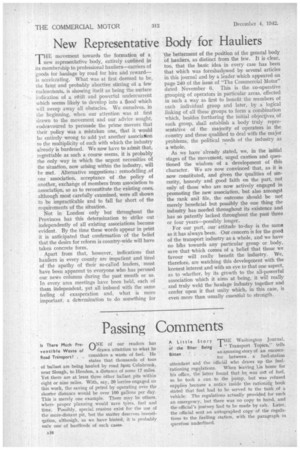Passing Comments
Page 18

Page 19

If you've noticed an error in this article please click here to report it so we can fix it.
nNE of our readers has
drawn attehtion to what he considers a waste of fuel. He states that thousands of tons of ballast are being hauled by road fcom
near Slough, to Hendon, a distance of some 17 miles. Yet there are at least three other ballast pits within eight or nine miles. With, say, 20 lorries-engaged on this work, the saving of petrol by operating over the shorter distance would be over 100 gallons per day. This is merely one example. There may be others, where proper planning would save tyres, fuel and time. Possibly, special reasons exist for the use of the more-distant pit, but the matter deserves investi
tion, although, as we have hinted, it is probably only one of huntlreds of such cases.
Is There Much Preventible Waste of Road Transport? . . A Little Story 'THE Washington Journal,
Of the Biter Being " Transport Topics," tells
Bitten " an amusing story of an encoun ter between, a fuel-station attendant and the official who draws up the fuelrationing regulations. When leaving his home for his office, the latter found that he was out of fuel, so he took a can to the pump, but was refused supplies because a notice inside the rationingbook stated that fuel. had to be served to the tank of a vehicle. The regulations actually provided for such an emergency, but there was no copy to hand, and the official's journey had to be made by cab. Later; the official sent an autographed copy of the regulations to the fuelling station, with the paragraph in question underlined.
I NSTRUCTION via the film always possesses a punch that is lacking in some of the more orthodox static forms of publicity, and a notable instance is to be found in the case of a film recently sponsored by the Edison Swan Electric Co., Ltd. It strikes a vital and topical note by stressing the need for the conservation and careful use of batteries, which are required on all classes of transport media in time of war. Many of the materials of which such equipment is compounded are in short supply, and by emphasizing the various phases of manufacture, and how troubles are created and prevented, the film does a good job of work, It can be hired, and should be in demand by Ministry film organizers, the Services' technical training branches, and by general battery users, such as roadtransport operators. It.tells an informative story quickly and to the point. Using the Cinema to Stress Battery's Wartime Importance
Will Many Fuiure .qEVERAL references have Vehicles Have Fourbeen made to that interest Wheel Drive ? . . ing American small four.
wheel-drive . military vehicle, the Peep. This is of all-metal cbnstruction with a lead capacity of 5 cwt., and it is claimed to be the' sttirdiest model ever made. It is produced in huge quantities at several American factories, the specifications vary slightly, but all working parts are interchangeable. It includes a four-cylindered engine developing 60 b.h.p. at 3,600 r.p.rn,; three speeds; a two-speed auxiliary transmission for extra-difficult work, and a rear-axle ratio of 4.88 to 1. On good roads the front drive can be thrown out of gear. The maximum speed is 60 m.p.h. It is thought by many that the use of four-wheel drive may have a strong effect upon the future design of vehicles in the U.S.A., imrticularly in respect of commercial types for medium and heavy duty.




















































